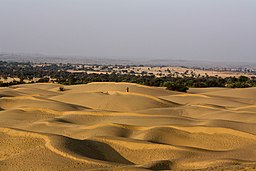Gurun Thar
Gurun Thar (bahasa Rajasthani: थार मरुधर, bahasa Hindi: थार मरुस्थल, bahasa Sindhi: ٿر ريگستان, bahasa Urdu: صحراےَ تھر), juga dikenali sebagai Gurun India Besar atau Marusthali (Tanah kematian), ialah sebuah kawasan gersang yang besar di bahagian barat laut subbenua India yang membentuk sempadan semula jadi antara India dan Pakistan. Ia merupakan gurun ke-17 terbesar di dunia, dan benua subtropika ke-9 terbesar dunia.[1] About 85% of the Thar Desert is in India, and the remaining part in Pakistan.[2] Di India, ia meliputi kira-kira 320,000 km2 (120,000 bt2), di mana 60% di Rajasthan dan meluas ke Gujarat, Punjab, dan Haryana.[3]
| Thar | |
| Gurun India Besar | |
| Desert | |
Gurun Thar Rajasthan, India
| |
| Negara-negara | India, Pakistan |
|---|---|
| Negeri | India: Rajasthan Haryana Punjab Gujarat Pakistan: Sindh Punjab |
| Biome | Gurun |

Rujukan sunting
- ^ Singhvi, A. K. and Kar, A. (1992). Thar Desert in Rajasthan: Land, Man & Environment. Geological Society of India, Bangalore.
- ^ Sinha, R. K., Bhatia, S., & Vishnoi, R. (1996). Desertification control and rangeland management in the Thar desert of India. RALA Report No. 200: 115–123.
- ^ Sharma, K. K. and S. P. Mehra (2009). The Thar of Rajasthan (India): Ecology and Conservation of a Desert Ecosystem. Chapter 1 in: Sivaperuman, C., Baqri, Q. H., Ramaswamy, G., & Naseema, M. (eds.) Faunal ecology and conservation of the Great Indian Desert. Springer, Berlin Heidelberg.
Bacaan lanjut sunting
- Bhandari M.M.- Flora of The Indian Desert, MPS Repros, 39, BGKT Extension, New Pali Road, Jodhpur, India.
- Rajendra Kumar. Gravis Jodhpur
- Govt. of India. Ministry of Food & Agriculture booklet (1965)—soil conservation in the Rajasthan Desert—Work of the Desert Afforestation Research station, Jodhpur.
- Gupta, R.K. & Prakash Ishwar (1975). Environmental analysis of the Thar Desert. English Book Depot., Dehra Dun.
- Kaul, R.N. (1967). Trees or grass lands in the Rajasthan: Old problems and New approaches. Indian Forester, 93: 434-435.
- Burdak, L.R. (1982). Recent Advances in Desert Afforestation. Dissertation submitted to Shri R.N. Kaul, Director, Forestry Research, F.R.I., Dehra Dun.
- Yashpal, Sahai Baldev, Sood, R.K., and Agarwal, D.P. (1980). "Remote sensing of the 'lost' Saraswati river". Proceedings of the Indian Academy of Sciences (Earth and Planet Science), V. 89, No. 3, pp. 317–331.
- Bakliwal, P.C. and Sharma, S.B. (1980). "On the migration of the river Yamuna". Journal of the Geological Society of India, Vol. 21, Sept. 1980, pp. 461–463.
- Bakliwal, P.C. and Grover, A.K. (1988). "Signature and migration of Sarasvati river in Thar desert, Western India". Record of the Geological Survey of India V 116, Pts. 3–8, pp. 77–86.
- Rajawat, A.S., Sastry, C.V.S. and Narain, A. (1999-a). Application of pyramidal processing on high resolution IRS-1C data for tracing the migration of the Saraswati river in parts of the Thar desert. in "Vedic Sarasvati, Evolutionary History of a Lost River of Northwestern India", Memoir Geological Society of India, Bangalore, No. 42, pp. 259–272.
- Ramasamy, S.M. (1999). Neotectonic controls on the migration of Sarasvati river of the Great Indian desert. in "Vedic Sarasvati, Evolutionary History of a Lost River of Northwestern India", Memoir Geological Society of India, Bangalore, No. 42, pp. 153–162.
- Rajesh Kumar, M., Rajawat, A.S. and Singh, T.N. (2005). Applications of remote sensing for educidate the Palaeochannels in an extended Thar desert, Western Rajasthan, 8th annual International conference, Map India 2005, New Delhi.
Pautan luar sunting
| Wikimedia Commons mempunyai media berkaitan Gurun Thar |
- Panduan pelancongan Gurun Thar dari Wikivoyage
- "Thar Desert". Terrestrial Ecoregions. Tabung Hidupan Liar Sedunia.
- Dharssi.org.uk, Photos of the Thar desert
- Avgustin.net Diarkibkan 2008-02-16 di Wayback Machine, Photos of the Thar desert in Pakistan side
- MIT.gov[pautan mati kekal], आपणो राजस्थान
